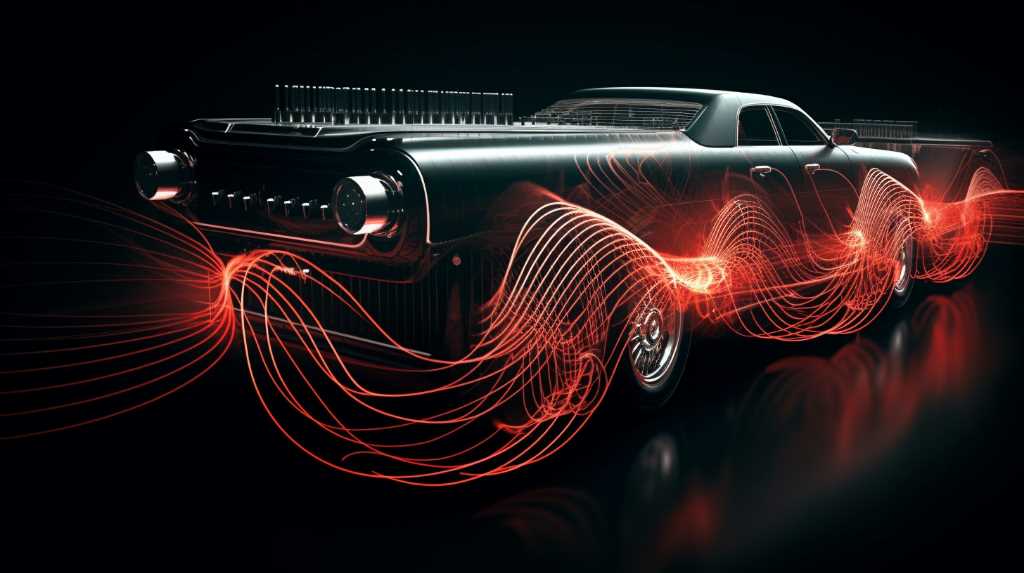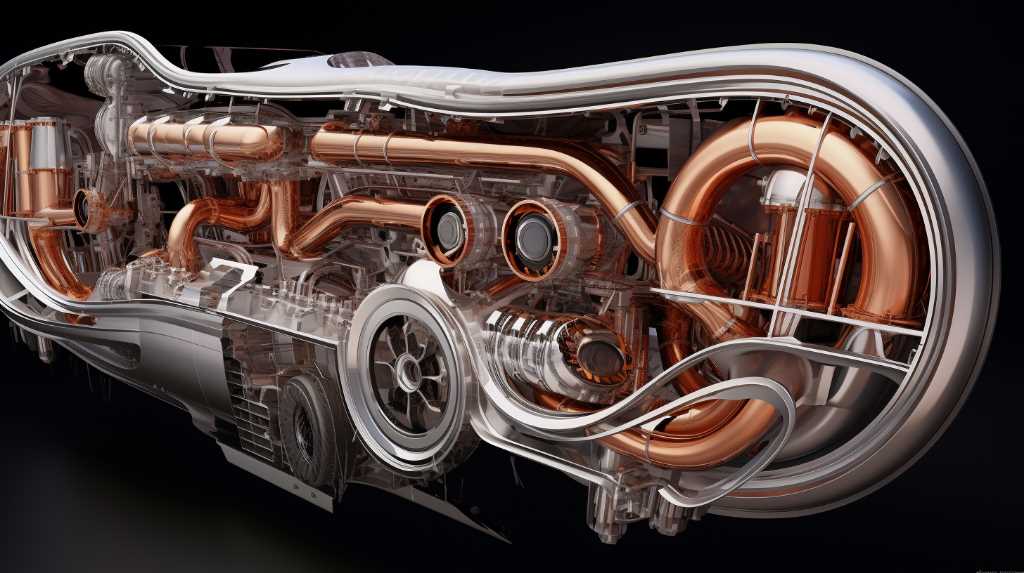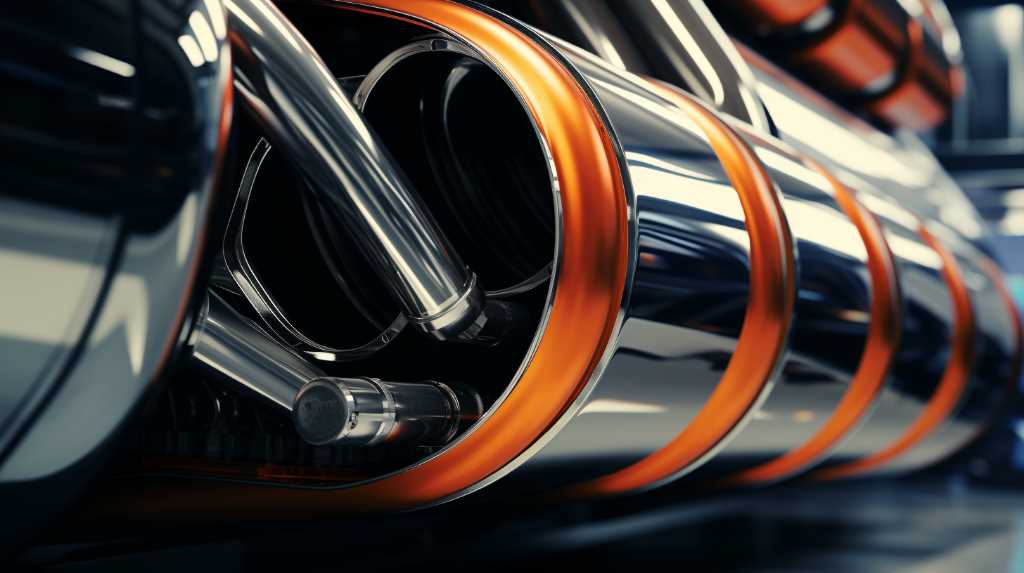Are you fascinated by the exhilarating roar of a powerful engine? Discover the art behind tuning exhaust sound and unleash a symphony of power. In this article, we will explore the role of acoustics in exhaust sound tuning, delve into the science of sound waves, and examine how exhaust system design impacts the overall sound.
Get ready to dive into the techniques used to adjust exhaust note frequency and learn how engineers fine-tune exhaust sound for both performance and aesthetics. The future of exhaust sound engineering awaits you.
Key Takeaways
- Acoustics play a crucial role in tuning exhaust sound, allowing designers to manipulate sound waves through the use of exhaust pipes, resonators, and mufflers.
- The design of the exhaust system can have a significant impact on the vehicle’s sound, emotional appeal, and performance factors such as backpressure, airflow, and engine output.
- Choosing the right combination of components, such as larger diameter pipes and straight-through mufflers for a deep sound or smaller diameter pipes and chambered mufflers for a subtle sound, can enhance the overall auditory experience.
- The sound produced by a well-tuned exhaust system adds emotion to the driving experience, resonates with emotions, and enhances driving enjoyment, while also impacting engine efficiency, power output, and overall performance.
The Role of Acoustics in Exhaust Sound Tuning
Acoustics play a crucial role in tuning the sound of your exhaust, giving your vehicle a distinct and powerful roar. When it comes to creating the perfect exhaust sound, acoustics are the key element that can enhance the overall driving experience.
By carefully designing the exhaust system, manufacturers can manipulate the sound waves produced by your engine, resulting in a unique and exhilarating sound. The size and shape of the exhaust pipes, as well as the placement of resonators and mufflers, all contribute to the final acoustics of your vehicle. These components work together to control the flow of exhaust gases and create specific sound frequencies.
With the right acoustics, your exhaust can produce deep rumbling tones or high-pitched screams, depending on your preference. Acoustic tuning not only adds a touch of personality to your vehicle but also provides a sense of power and performance. The sound of a well-tuned exhaust can turn heads and make a statement on the road.
Understanding the Science of Sound Waves

To truly grasp the intricacies of exhaust sound tuning, you need to understand how sound waves behave and interact with the components of your vehicle’s exhaust system. Sound waves are created when an object vibrates, causing the surrounding air molecules to vibrate as well. These vibrations then travel through the air in the form of waves, reaching our ears and allowing us to perceive sound. The characteristics of a sound wave, such as its frequency and amplitude, determine the pitch and volume of the sound we hear.
In the context of exhaust sound tuning, understanding sound waves is crucial because it helps us manipulate the desired sound produced by the engine. By modifying the shape and size of the exhaust pipes, mufflers, and resonators, we can affect the way sound waves travel through the system. For example, a larger diameter pipe can allow more sound waves to pass through, resulting in a deeper and louder exhaust note. On the other hand, a muffler or resonator can be designed to reflect or absorb certain frequencies, altering the sound produced by the engine.
The Impact of Exhaust System Design on Sound

When it comes to the impact of exhaust system design on sound, there are several key points to consider. Firstly, designing a sound-enhancing exhaust involves carefully crafting the shape and size of the components to create a desired sound profile. Next, the emotional appeal of a vehicle can be greatly influenced by the sound it produces, with a powerful and aggressive exhaust note evoking feelings of excitement and exhilaration. Lastly, the design of an exhaust system can also have implications on performance, as it can affect factors such as backpressure and airflow, ultimately influencing the engine’s output.
Designing Sound-Enhancing Exhaust
Create an exhaust system that enhances the sound of your vehicle by carefully considering the design. The design of an exhaust system plays a crucial role in determining the sound it produces. The shape and size of the exhaust pipes, mufflers, and resonators all contribute to the final sound that’s emitted from your vehicle.
By choosing the right combination of components and optimizing their design, you can create a sound-enhancing exhaust system that perfectly matches your vehicle’s character. For a deep and aggressive sound, larger diameter pipes and straight-through mufflers can be used. On the other hand, if you prefer a more refined and subtle sound, smaller diameter pipes and chambered mufflers may be the way to go.
It’s important to experiment and fine-tune the design to achieve the desired sound for your vehicle.
Emotional Appeal Through Sound
Choose the right exhaust system design and experience the powerful emotional appeal that comes from the perfect sound. The impact of exhaust system design on sound can’t be underestimated. When you rev the engine and hear that deep, rumbling growl, it stirs something inside you. It evokes a sense of power, excitement, and adrenaline. The sound of a well-tuned exhaust system can make your heart race and put a smile on your face. It adds an extra layer of emotion to the driving experience, making it more engaging and enjoyable.
Whether you prefer a throaty roar or a high-pitched scream, the right exhaust system design can amplify the personality of your vehicle and create a unique auditory experience that resonates with your emotions.
Performance Implications of Sound
Get ready to experience the full potential of your vehicle’s performance with the right exhaust system design and the harmonious symphony of power it produces. The impact of exhaust system design on sound goes beyond just creating an appealing auditory experience. It actually has significant performance implications.
By optimizing the exhaust system design, you can enhance the flow of exhaust gases, resulting in improved engine efficiency and power output. A well-designed exhaust system can provide better scavenging, reducing back pressure and allowing the engine to breathe more freely. This can lead to increased horsepower and torque, giving you a noticeable boost in acceleration and overall performance.
Additionally, the right exhaust system design can help reduce weight, improving the power-to-weight ratio and further enhancing your vehicle’s performance capabilities. So, choose wisely and unleash the full potential of your vehicle’s performance with an exhaust system that not only sounds great but also delivers optimal power.
Techniques for Adjusting Exhaust Note Frequency

To achieve a distinctive exhaust note frequency, you can experiment with various techniques for tuning your vehicle’s exhaust system.
One technique is to change the size and shape of the exhaust pipes. By increasing the diameter of the pipes, you can lower the exhaust note frequency, resulting in a deeper and more aggressive sound. On the other hand, decreasing the diameter will raise the frequency, giving your vehicle a higher-pitched and sportier sound.
Another technique is to modify the muffler design. A straight-through muffler, also known as a performance muffler, allows for better airflow and can produce a louder and more resonant sound. Conversely, a chambered muffler can help to muffle the sound and create a quieter and more refined exhaust note.
Additionally, you can consider adding a resonator to the exhaust system. A resonator acts as an acoustic filter, helping to control the sound waves and produce a more pleasing exhaust note. Lastly, modifying the exhaust manifold can also affect the exhaust note frequency. By using headers with longer or equal-length tubes, you can create a more balanced and harmonious sound.
Fine-tuning Exhaust Sound for Performance and Aesthetics

To achieve optimal performance and aesthetics, you can enhance the exhaust sound by combining different tuning techniques. One of the first things you can do is install a performance exhaust system. This system is designed to improve both the flow of exhaust gases and the sound produced. By replacing the stock exhaust system with a performance one, you can achieve a deeper and more aggressive tone.
Another technique is the use of resonators. Resonators are chambered tubes that are strategically placed in the exhaust system to manipulate sound waves. By adjusting the size and length of the resonators, you can alter the exhaust note to your liking.
Additionally, you can consider installing an electronic valve system. This system allows you to control the exhaust sound by opening or closing the valves as desired. By opening the valves, you can unleash a louder and more powerful exhaust note, while closing them will result in a quieter and more subtle sound.
Lastly, you can experiment with different exhaust tip designs. The shape and size of the exhaust tips can have an impact on the sound produced. For instance, larger tips tend to create a deeper and louder sound, while smaller tips produce a more refined tone.
The Future of Exhaust Sound Engineering

With advancements in technology and the constant desire for innovation, you can expect the future of exhaust sound engineering to be a harmonious blend of creativity and precision. As automotive manufacturers continue to push the boundaries of performance and sustainability, exhaust sound engineering is evolving to meet the demands of both drivers and environmental regulations.
One of the key areas of focus in the future of exhaust sound engineering is customization. With the advent of electric and hybrid vehicles, engineers are exploring ways to recreate the visceral experience of a traditional combustion engine. Through the use of advanced sound synthesis technologies, drivers will be able to choose from a range of exhaust sound profiles, tailored to their personal preferences.
Another aspect that will shape the future of exhaust sound engineering is the integration of artificial intelligence (AI). AI algorithms can analyze various factors such as engine RPM, throttle position, and vehicle speed, to generate real-time adjustments to the exhaust sound. This technology will enable a seamless transition between different sound profiles, enhancing the driving experience and providing a sense of connection with the vehicle.
Furthermore, the future will see increased collaboration between automotive manufacturers and audio experts. By combining their expertise, these professionals can create exhaust sound systems that not only meet regulatory requirements but also enhance the overall driving experience. This collaboration will result in exhaust sound engineering becoming a key aspect of vehicle design and branding.
Frequently Asked Questions
How Does Exhaust Sound Tuning Affect the Performance of a Vehicle?
Exhaust sound tuning affects your vehicle’s performance by optimizing engine airflow, enhancing power and torque, and improving fuel efficiency. It also adds a distinctive and powerful sound that enhances the overall driving experience.
Can the Sound of an Exhaust System Be Adjusted to Meet Legal Noise Regulations?
Yes, you can adjust the sound of your exhaust system to meet legal noise regulations. By tuning the exhaust sound, you can ensure compliance while still enjoying the powerful symphony of your vehicle’s engine.
Are There Any Health Risks Associated With Certain Exhaust Sound Frequencies?
Certain exhaust sound frequencies can pose health risks. It’s important to be mindful of the potential effects on your well-being. Take precautions and consider the impact on yourself and others.
Does the Material Used in the Construction of an Exhaust System Affect the Sound It Produces?
Yes, the material used in the construction of an exhaust system does affect the sound it produces. Different materials can alter the tone and volume of the exhaust sound, giving it a unique character.
Are There Any Aftermarket Options Available for Adjusting the Sound of a Stock Exhaust System?
Yes, there are aftermarket options available for adjusting the sound of a stock exhaust system. These options can include installing a different muffler or resonator, or adding a sound-enhancing device.
Conclusion
In conclusion, the art of tuning exhaust sound is a symphony of power and precision. By understanding the science of sound waves and utilizing techniques for adjusting exhaust note frequency, engineers are able to create the perfect balance between performance and aesthetics.
With advancements in exhaust system design and the continuous evolution of sound engineering, the future holds endless possibilities for creating the ultimate symphony of power. So buckle up and get ready to experience the exhilarating sound of a finely-tuned exhaust system.
Related Articles
The Ultimate Guide to Performance Car Exhaust Systems
Next Exhaust Article: Choosing the Right Exhaust Material: Stainless Steel Vs. Other Options
Previous Exhaust Article: Track-Ready Exhausts: What Racers Need to Know About Performance Exhaust Systems

Hey there, I’m Terra Frank, the driving force behind Motion Performance Motor Sports. I’m thrilled to have you here, exploring the fascinating world of cars, trucks, and everything related to automotive performance and accessories.




